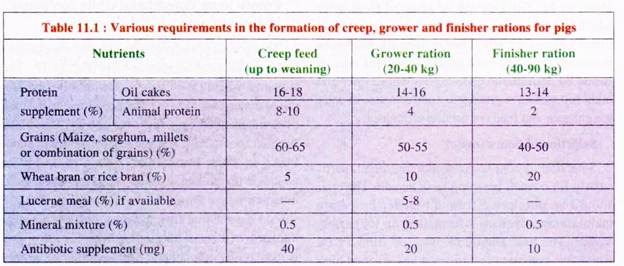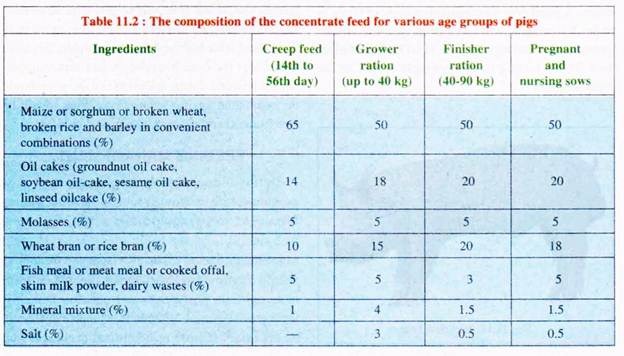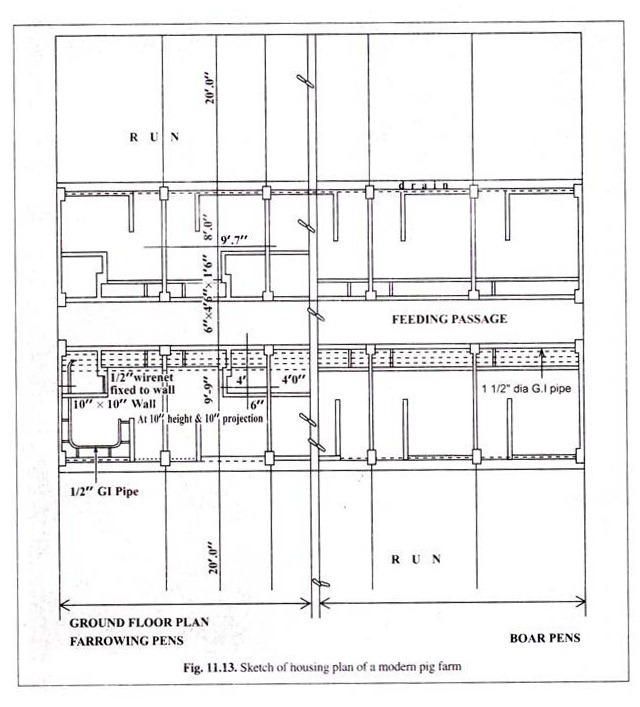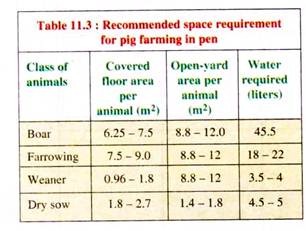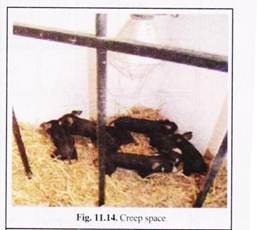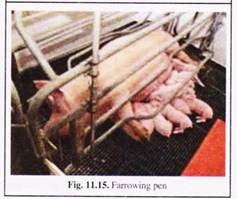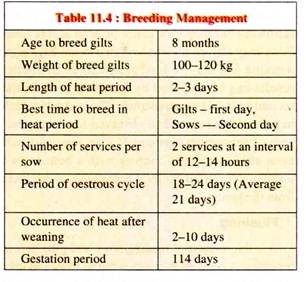Introduction to Feeding Management:
During formulation of supplement food most economical ingredients should be selected. Grains like maize, sorghum, oat, other millets, wheat and rice should form the basic ingredients. Protein supplements like oil cakes, fish meal and meat meal should be provided.
No vitamin supplements are necessary if the pigs are allowed to pasture or are fed fresh green legumes. Vitamin B12 supplement would be necessary if little or no animal protein is fed. Antibiotic supplements at the rate of 11 mg of antibiotic per kilogram of ration and mineral supplements should be provided.
In Tables 11.1 and 11.2, details of specific formulation of the various requirements in the formation of creep, grower and finisher rations for pigs are given.
The farmer should prepare the complete ration recommended (Table 11.2) for different classes and provide the pigs the amount they will eat without waste two or three times daily. The following is the approximate amount of dry feed the pigs will consume per day. All grains in mixed feeds should be ground. Generally feeding in the form of wet mash is not superior to (slop feeding) dry feeding.
Slop feeding requires more time and excessive labour. If a ration is fairly high in fibre, pelleting the feed may increase the rate and efficiency of gain in weight. Pelleting may also decrease the amount of feed that is wasted.
It is important not to overfeed sows which have been bred. Overfat sows are apt to produce weak pigs and crush more piglets at farrowing. Sows should gain about 35 kg and gilts about 55 kg from breeding to farrowing.
Housing of Pigs:
Good housing with adequate accommodation incorporating all essential requirements of pigs must be provided so that the animals can grow quickly and efficiently. This is only possible through scientific housing which includes the provision for fresh air, exercise, sunlight protection from inclement weather conditions.
ADVERTISEMENTS:
Pigs are very much susceptible to extremes of heat and cold. Pigs are poorly provided with heat regulating mechanism and sweating only takes place from the snout. So it is difficult to keep them cool in hot weather. Temperature in a pig house is, therefore, one of the most important factors to be taken into consideration while erecting a pig house particularly in tropical countries.
Systems of Housing Pigs:
Pigs are kept under two systems:
(a) Open air system, and
(b) Indoor system.
ADVERTISEMENTS:
A combination of the two is, however, followed in most places in this country. Both these systems have advantages and disadvantages. The size of the enterprise, the type of pigs to be produced, the availability of land and the climatic conditions are the guiding factors for choosing the housing system.
In case of farms with small holdings no special purpose in pig house is necessary but in a specialised farm accommodating a large number of animals, there may be the necessity of constructing special purpose houses for different categories of stocks, e.g., breeding stock and store pigs. The housing system will also vary depending on whether the pigs are kept under pasture or indoor, or a combination of the two.
Housing:
Adequate housing and equipment for raising pigs are necessary to provide shelter against inclement weather, prevent diseases, control parasites and save labour (Figure 11.13). The normal requirement of floor area, water and air space in pens for various classes of pigs is given in Table 11.3.
Creep Space:
The flooring should have a rough finish and should be of a regular masonry type made up of waterproof cement mortar (Figure 11.14). Proper drains should be provided so that the effluents are disposed of.
Generally under village conditions the housing can be made up of pens measuring 3 m x 2.4 m or 3 m x 3 m with an open yard of nearly the same dimension or in some cases slightly longer. Walls should be 1.2-1.5 m high from the floor.
For the purposes of farrowing some of the pens could be converted into farrowing pens (Figure 11.15) by providing guard rails made up of G.I. pipes of 5 cm diameter along the walls, 20-25 cm from the ground and the wall.
In addition to guard rails, creep space can be provided for the piglets along the wall by making a partition or in one of the corners with separate entrances for the piglets. This space usually measured as 0.75 m x 2.4 m area. In many of the farms the yard is provided with regular flooring.
Prolonged exposure of exotic breeds of pigs to bright sunshine may cause pigs to become overheated even during moderate weather. Shade helps in preventing deaths and increasing production efficiency during hot weather.
Planting of trees in the neighborhood of pens for reducing the intensity of heat is recommended. But it is not desirable to plant large trees for giving regular shade because they permit rapid build-up of parasite levels.
Location of the Farm:
The farm should be located near the city where there is a heavy demand of pork products. This is particularly necessary to avoid the cost of transport of feed and other stuff as also for disposal of animals. Where pedigree pigs are sold in large numbers it is advantageous to locate the house near a railway station.
Proximity to public utilities like electricity, gas and water supply will be an added help to the farm. At the same time the farm should not be situated in the municipal areas where there might be objection in future from health authorities as also for future possibilities of expansion.
Layout of building has a marked influence on efficient working. The most important item to be considered is the facility for proper sanitation with a good drainage system. The building should be situated in such a way that doors and windows will receive maximum sunlight and the pigs will get shelter from prevailing direction of the wind.
Wallows:
Pigs have very few sweat glands. In areas having warm weather mature breeding animals and fattening animals need a wallow during summer months. Instead of permitting unsanitary wallows a masonry wallow with proper drainage would be desirable. The size of the wallow will depend upon the number and size of the animals.
Age of Breeding Stock:
Well-developed gilts may as a general rule breed to farrow when 12-14 months old. This depends more on development than on age. Gilts should weigh at least 120 kg before breeding. Ovulation rate increases during successive oestrous periods (up to fifth) following puberty. Thus it is advantageous to delay the breeding of gilts until the second or third oestrous.
Litter size increases on an average in succeeding pregnancies up to 5th or 6th litter. It is therefore, advantageous to cull the sow from a breeding herd or a commercial herd after her fifth or sixth litter as the litter size goes down thereafter. The detail of breeding management is given in Table 16.4.
Detection of Heat:
The average length of oestrous cycle in pigs is 21 days. The oestrous symptoms last for five to seven days beginning with vulvar swelling and vaginal discharge. In true oestrous there is frequent urination, reduced appetite, mounting and standing for service detected by the erection of ears and immobility when normal pressure is applied to the back.
The application of pressure on the back is used to determine the correct breeding time. Animals with a predisposition for weak oestrous should be brought near the boar to exhibit heat symptoms a little more clearly.
Best time for breeding is during the latter half of the first day or early on the second day of oestrous. In many cases the gilts and sows continue to exhibit the standing heat on the next day. In these cases the animals should be rebred and the interval in the case of rebreeding should be 12-14 hours. This procedure will ensure a high conception rate in the herd.
Sows come into oestrous one to four days after farrowing but they should not be bred at this time. Sows may also come into heat two to ten days after weaning and may be bred at this time. But better results can be obtained by breeding them in the second post lactation oestrous.
The animals which have been bred should be observed for the appearance of subsequent oestrous. If sows not conceived even after successful mating with a boar in two continuous oestrous cycles it is desirable to cull them from the herd.
Flushing:
It is the method of feeding sows and gilts before breeding. A good grower ration fed to sows and gilts seven to ten days before breeding helps in increased ovulation rates in them. After breeding sows and gilts should be fed a limited but well balanced ration until the last six weeks of pregnancy and then full feeding should be resumed.
Care and Management of Pregnant Animals:
The gestation period of sow varies from 109-120 days with an average of 114 days. Pregnant animals should be housed in groups in separate enclosures to avoid fighting which may result in abortion. It would also be advisable to house pregnant gilts and sows in separate groups during gestation.
About 3 m2 of dry housing should be available for each sow. The pregnant animals should be allowed to move about every day in the morning on a free range or a pasture, if available. A pasture area is presumed to be clean, if a cultivated crop was raised.
Management at Farrowing:
Farrowing time is the critical time in pig production. Death rate is high during farrowing and the first week after farrowing. Sows may be farrowed in pens equipped with guard rails and a creep space in farrowing crates or in farrowing stalls. A pen equipped with guard rails and a creep space is adequate.
The pen should be maintained at 24°C to 28°C until the piglets is three or four days old and at 18°C to 22°C until the piglets are approximately six weeks old. The heat lamps should be hung 45 cm from the floor and suitably protected. The farrowing pens should be thoroughly cleaned before the sow is brought in. This will prevent a large number of diseases of piglets.
The sow should bring to the farrowing pen at least one week prior to farrowing so that it becomes familiar with the surroundings. She should be washed thoroughly before being brought to the farrowing pen. The feed ration should be made bulky by substituting one-third of the regular ration with wheat bran.
The amount of ration fed should also be reduced by one third till the sow farrows! The sow should be watched closely for determining the approximate time of farrowing and feed should not be given 12 hours before farrowing.
Care during Farrowing:
An attendant should be on hand when the sow farrows. Otherwise many piglets will die. It takes generally 2 to 4 hours for complete farrowing to take place. The piglets should be removed as they are farrowed and kept warm in the creep space until farrowing is complete. Each piglet should be cleaned of all mucus to ensure that the breathing passages are clear.
The navel cord should be tied 2-5 cm away from the navel, cut with a disinfected pair of scissors and the stumps painted with iodine. Piglets should be allowed to be nursed after birth. In about 2 days they settle down to their individual teats. They nurse 8-10 times in 24 hours in the initial period. Trampling by the sow should be prevented during the first two weeks.
Removal of Needle Teeth:
Piglets are born with four pairs of sharp teeth (needle teeth), with two pairs on each jaw. They are of no practical use to the piglets and they may irritate the sow’s udder during nursing or cause injury to other piglets. Clipping of these teeth shortly after birth will prevent the injury of the udder caused by the needle teeth.
Anaemia in Piglets:
Anaemia is a common nutritional disease in piglets. This condition can be prevented and cured by supplying iron either orally or by injection. Oral administration consists of spraying or swabbing the sow’s udder with a saturated solution of ferrous sulphate (0.5 kg of ferrous sulphate in 10 liters of hot water).
This solution must be applied daily from birth until the piglets start eating creep feed. Intra-muscular infection of iron-dextran compounds is the more effective method of preventing anaemia.
Raising Orphan Piglets:
The death of a sow after farrowing, mastitis, lactation failure of litters larger than the sow is able to raise, resulting in orphan pigs. If another sow has farrowed within a short time of the first farrow, the orphan piglets may be transferred to her.
This transfer must be made within a few days after farrowing because those sections of sow’s udder, not used, soon cease producing milk. To ensure acceptance of new pigs the sow should be separated from her own litter for short time and then the new piglets are brought to her and a disinfectant or other material should be sprinkled on all the piglets to mask the odour.
Orphan piglets can also be raised with milk replacer. Milk replacer consists of one egg yolk thoroughly mixed with one litre of cow milk. This mixture supplies a well-balanced diet except for iron. To compensate for the lack of iron one-eighth tea spoon-full of ferrous sulphate may be added to one litre of milk. An injection with iron compound may also be used.
Castration:
The male piglets not selected for breeding may be castrated when they are three to four weeks old.
Management during Lactation:
Sows and gilts should be fed with good judgment during lactation. When fully fed a sow needs about 0.5 kg of feed per piglet she is nursing in addition to her own requirements.
Separation of Piglets from Mother (Weaning):
Normal weaning age of piglets is 8 weeks. The sow should be separated from the piglets for a few hours each day to prevent stress of weaning and feed is reduced gradually. The piglets should be dewormed after 2 weeks of weaning.
The piglets should be gradually shifted from 18 percent protein creep feed to 16 per cent grower ration over a period of two weeks. Group of 20 piglets of more or less the same age should be housed in each pen.
Prevention and Control of Swine Diseases:
i. All pigs should be vaccinated against swine fever at the age of 2-4 weeks. Breeding pigs should be tested for brucellosis and leptospirosis. As a routine measure all young pigs at the time of weaning should be inoculated against swine fever.
ii. Animals for the farm should be purchased from disease-free herds. Newly purchased animals should be isolated from the other animals in the farm for a period of three to four weeks. No visitor will be allowed visiting the farm. Those stys or pig houses cleared of the animals are kept empty for three to four weeks for destruction of micro-organisms causing the disease.
Economy of Pig:
The pig population of the country is 13.291 million as per 1997 livestock census. Provisional result of census from states reveals that it constitutes around 1.30% of the total world’s population. During 2011-12 the production of pork and pork products were estimated to be 672550 metric tons, with 3.03% growth rate in last decade.
It comprised over 38% of the total world meat product. Indian share in piggery meat production moderately increased from 0.53% in 1981 to 0.63% in 2002 to 0.75% in 2012.
The contribution of pork products in terms of value works out to 0.80% of total livestock products and 4.32% of the meat and meat products. The contribution of pigs to Indian exports is very poor. About 934 tons of pork and pork products were exported during 1995-96. The value of pork and pork products exported is Rs. 262.00 lakh against the total value of Rs. 61604.00 lakh on account of meat and meat products export.
The pig farming constitutes the livelihood of rural poor belonging to the lowest socio-economic strata and they have no means to undertake scientific pig farming with improved foundation stock, proper housing, feeding and management.
Therefore, suitable schemes to popularise the scientific pig breeding cum rearing of meat producing animals with adequate financial provisions are necessary to modernise the Indian pig industry and to improve the productivity of small sized rural pig farms.
In view of the importance of pig farming in terms of its contribution to rural poor and possible potentials for pig rearing in our country, Government of India has initiated measures to promote the pig farming on scientific lines under its five year plans.
The first step towards this direction is establishment of eight bacon factories and organisation of pig production in rural areas attached to bacon factories. In order to make available good foundation stock, regional pig breeding stations were established for each bacon factory. Further expansion of pig breeding programmes paved the way for establishment of 115 pig breeding farms (1992-93) throughout the country.
